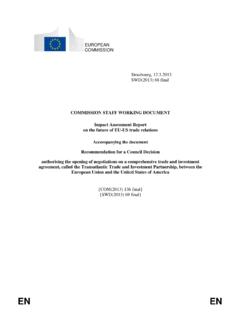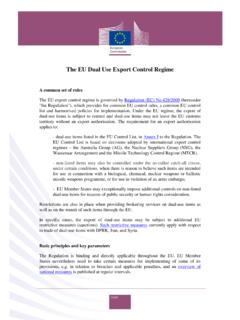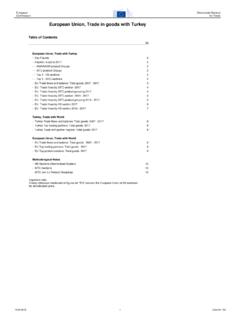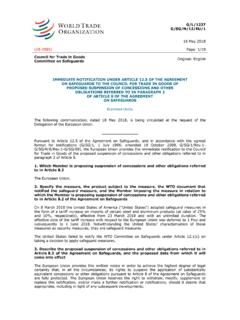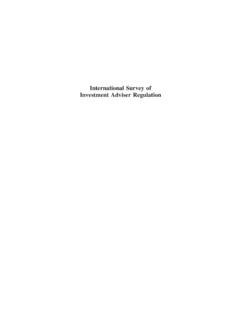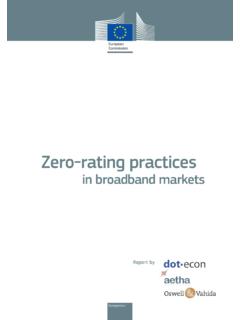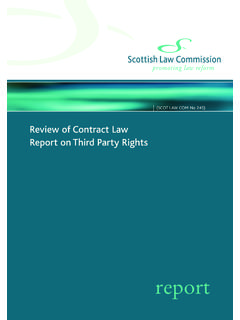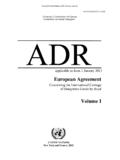Transcription of The EU’s new Generalised Scheme of Preferences (GSP)
1 The EU s new Generalised Scheme of Preferences (GSP) For more information: December 2012 Highlights of the new GSP -What is GSP? -Why has the EU updated GSP? -Focus on need: which countries? -What will change regarding graduation of competitive sectors? -A limited product expansion and increase of preference margins -What happens to GSP+? -What happens to EBA? -Enhancing stability and predictability -Other changes -Institutional adaptations -So what happens next? Annex I. Salient features of the current EU GSP Scheme Annex II. "Overseas countries and territories" Annex III. Partners with another market access arrangement Annex IV. High-income countries and upper-middle income countries Annex V. List of beneficiaries under the new GSP Annex VI. Products which have been incorporated into the new GSP; products with higher Preferences under the new GSP Annex VII.
2 List of graduated sectors for the period 1 January 2014 31 December 2016 Annex VIII. Overview of institutional provisions DISCLAIMER: This info pack is not a legal text and has been prepared exclusively for information purposes. This should not be used by any party as a basis for any decisions with legal implications. The exclusive legal basis for the new GSP is Regulation (EU) No 978/2012 of the European Parliament and of the Council. C 2 Highlights of the new Generalised Scheme of Preferences What is the Generalised Scheme of Preferences ? The EU's Generalised Scheme of Preferences (GSP), created following UNCTAD recommendations, helps developing countries (DC) by making it easier for them to export their products to the European Union. This is done in the form of reduced tariffs for their goods when entering the EU market.
3 Through the additional export revenue which is generated, GSP fosters growth in their income and supports economic growth and job creation. The GSP is a specific instrument focussing on a single dimension only: Preferences for trade in goods. It does not have the ambition or the possibility to tackle other problems faced by developing countries. Only a much broader policy mix can address those complex issues. The GSP is subject to WTO law, in particular to the GATT and the so-called "Enabling Clause" which allows for an exception to the WTO "most-favoured nation" principle ( equal treatment should be accorded to all WTO Members). As the needs of developing countries vary widely a differentiated approach has been taken in GSP, providing a sliding scale of Preferences according to different needs: (1) Duty reductions for ca.
4 66% of all tariff lines for beneficiaries in general. 111 countries and territories enjoy these reductions, and in 2011 exported products worth billion thanks to these Preferences . This is 83% of all imports benefiting from GSP Preferences . (2) Zero duties for essentially the same 66% tariff lines for countries which implement core human rights, labour rights and other sustainable development conventions ( GSP+ ). There are 16 beneficiaries which exported in 2011 4 billion thanks to these Preferences . This is 5% of all GSP Preferences . (3) Full duty free, quota free access for all products except arms (Everything But Arms, or EBA ) for Least Developed Countries (LDCs). There are 49 beneficiaries which exported in 2011 products under GSP worth billion 12% of all GSP Preferences . See Annex I for a more detailed explanation of the building blocks of the GSP Scheme .
5 C 3 Highlights of the new Generalised Scheme of Preferences Why has the EU updated the Generalised Scheme of Preferences ? A powerful institutional reason to change the instrument is the entry into force of the Lisbon Treaty. This requires the redesign of the GSP Regulation to reflect the new institutional environment, with the reinforced role of the European Parliament in trade policy. From a substantive point of view, the Commission engaged in a mid-term review of the instrument. Extensive preparatory analysis (independent studies and the Commission's own Impact Assessment) and a broad public consultation has shown that, while it has been successful in achieving its objectives, our GSP is no longer adapted to the current global landscape. To remain relevant and efficient, the GSP has been updated along the following lines: 1.
6 Better focus on those countries most in need The last decade has seen the emergence of more advanced developing countries, which are now competitive on a global scale. We are providing Preferences to many such countries and sectors which no longer need them: the more advanced economies have successfully integrated in world trade. On the other hand, many poorer countries are lagging behind. They are affected by competition from the more advanced developing countries which often export very similar products. Currently, the GSP Preferences increase the competitive advantage of more advanced developing countries at the cost of exports from the Least Developed Countries (LDCs) and low-income economies. In fact, 40% of preferential exports are absorbed by the more advanced countries. This goes some way to explain the disappointing performance of the poorest.
7 Hence the need to concentrate Preferences on those that most need them: low and lower middle income countries. This need is the more urgent as tariffs continue to drop as a result of multilateral and bilateral trade liberalisation. With tariff levels falling, Preferences also diminish a process called preference erosion . The more advanced countries can compete effectively with low or no Preferences but the poorer, if they are to successfully join the path of export-led growth and development, will need to exploit the diminishing Preferences to the The clock is ticking. C 4 Highlights of the new Generalised Scheme of Preferences 2. Further promote core principles of sustainable development and good governance The GSP+ arrangement, which provides additional Preferences to countries which ratify and implement a number of international conventions on core human and labour rights, the environment and good governance, has had a positive impact on the ratification of such conventions.
8 Hence this Scheme should provide stronger incentives for additional countries to sign up to and implement relevant international conventions. 3. Enhance legal certainty and stability The success of the GSP regime depends on the ease with which exporters and importers can use its Preferences . The EU should ensure that the Scheme is sufficiently stable and predictable for all economic operators. Focus on need: which countries? The new GSP focuses Preferences exclusively on those countries that need them. The number of GSP beneficiaries is expected to be reduced from today s 176 to 89. Countries with other preferential regimes to access the EU market The first set of countries which do not need GSP contains countries and territories which already have other preferential channels to enter the EU.
9 As those preferential channels are typically better than GSP, it is no wonder that they use GSP only marginally, if at all. Two broad groups can be established: 1. 33 overseas countries and territories (see Annex II), mainly EU territories but also some US, Australian and New Zealand territories. The US, Australia or New Zealand are developed countries and therefore do not have the same needs as developing countries. As to EU territories, they have their own market access regulation. Given that GSP exports to the EU by these countries are marginal (if at all), the option of utilising GSP risks creating confusion for operators. These territories will cease to be eligible for GSP. Because of alternative market access arrangements, we expect that reform will be neutral for them.
10 2. 34 countries with FTAs or other preferential market access arrangements (see Annex III). These countries enjoy another trade arrangement with the EU which provides substantially equivalent (or better) coverage as C 5 Highlights of the new Generalised Scheme of Preferences compared to GSP. This includes countries with a Free Trade Agreement or with autonomous arrangements (such as the Market Access Regulation for countries with an Economic Partnership Agreement (EPA) or the special regime for Balkan countries). These countries will remain eligible but will cease to receive Preferences (they will not be beneficiaries ) this nuance is important as they could come back into the beneficiary list if the preferential market arrangement was terminated. Again, use of GSP is marginal if at all by these countries.

